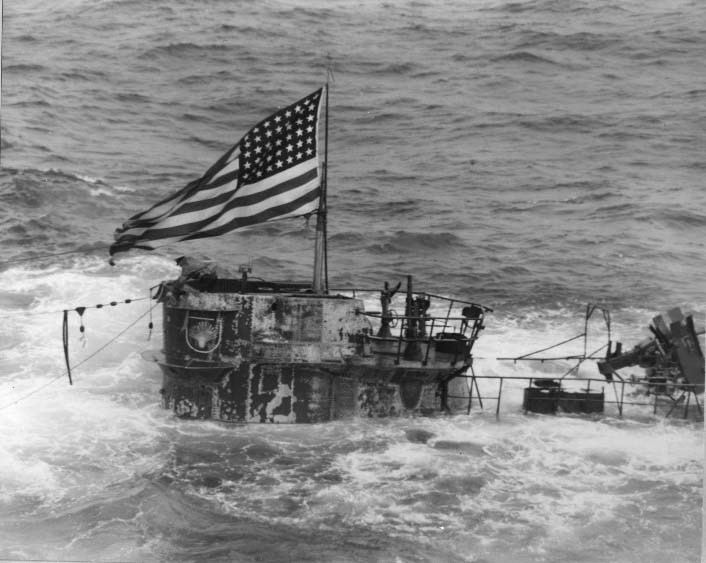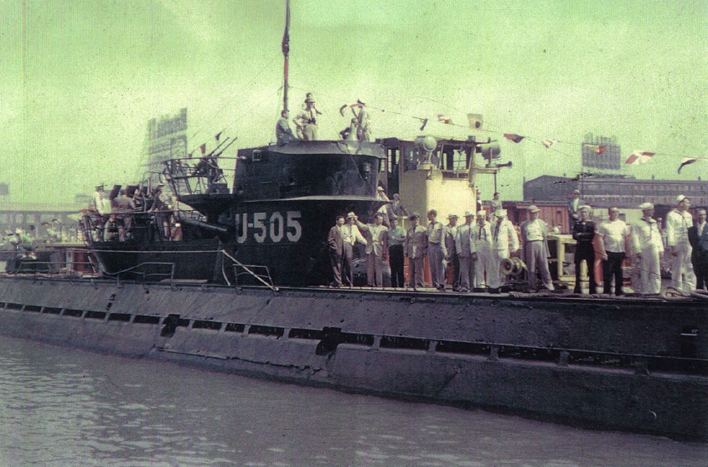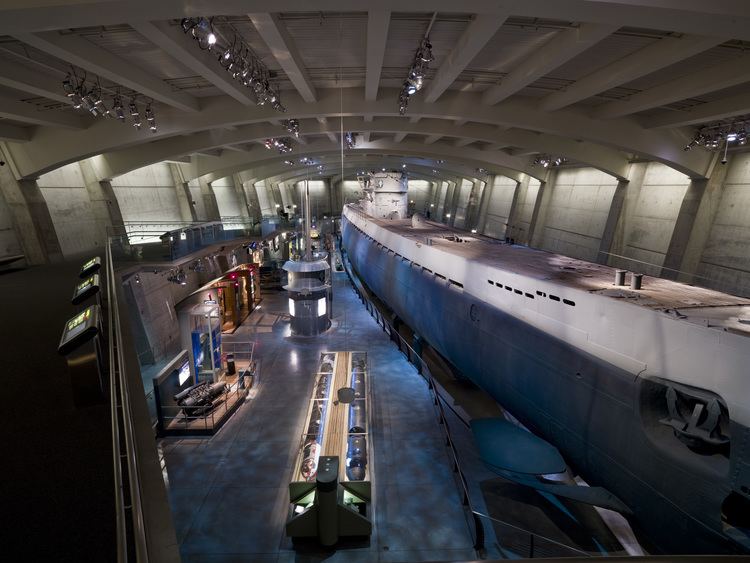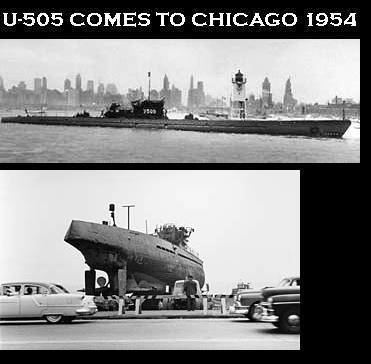Name U-505 Yard number 295 Commissioned 26 August 1941 Construction started 12 June 1940 Beam 6.76 m Builder Deutsche Werft | Ordered 25 September 1939 Laid down 12 June 1940 Length 77 m Launched 24 May 1941 Year built 1941 | |
 | ||
Fate Captured on 4 June 1944 by US Navy ships in the Atlantic. Similar German submarine U 534, German submarine U 995, German submarine Wilhelm Bauer | ||
U-505 is a German Type IXC U-boat built for Nazi Germany's Kriegsmarine during World War II. She was captured on 4 June 1944 by United States Navy Task Group 22.3 (TG 22.3). Her codebooks, Enigma machine, and other secret materials found on board helped the Allied codebreakers.
Contents
- Design
- Service history
- First patrol
- Second patrol
- Third patrol
- Fourth patrol
- Botched patrols
- Tenth patrol Zschechs suicide
- Eleventh patrol
- Wolfpacks
- Anti sub task force
- Detection and attack
- Salvage operations
- Outcome
- Museum ship
- Popular culture
- References
All but one of U-505's crew were rescued by the Navy task group. The submarine was towed to Bermuda in secret and her crew was interned at a US prisoner-of-war camp where they were denied access to International Red Cross visits. The Navy classified the capture as top secret and prevented its discovery by the Germans.

In 1954, U-505 was donated to the Museum of Science and Industry in Chicago, Illinois and is now a museum ship.

She is one of six U-boats that were captured by Allied forces during World War II, and the first warship to be captured by US forces on the high seas since the War of 1812. In her uniquely unlucky career with the Kriegsmarine, she also had the distinction of being the "most heavily damaged U-boat to successfully return to port" in World War II (on her fourth patrol) and the only submarine in which a commanding officer took his own life in combat conditions (on her tenth patrol, following six botched patrols). U-505 is one of four German World War II U-boats that survive as museum ships, and one of two Type IXCs still in existence, the other being U-534.

Design

German Type IXC submarines were slightly larger than the original Type IXBs. U-505 had a displacement of 1,120 tonnes (1,100 long tons) when at the surface and 1,232 tonnes (1,213 long tons) while submerged. The U-boat had a total length of 76.76 m (251 ft 10 in), a pressure hull length of 58.75 m (192 ft 9 in), a beam of 6.76 m (22 ft 2 in), a height of 9.60 m (31 ft 6 in), and a draft of 4.70 m (15 ft 5 in). The submarine was powered by two MAN M 9 V 40/46 supercharged four-stroke, nine-cylinder diesel engines producing a total of 4,400 metric horsepower (3,240 kW; 4,340 shp) for use while surfaced, two Siemens-Schuckert 2 GU 345/34 double-acting electric motors producing a total of 1,000 shaft horsepower (1,010 PS; 750 kW) for use while submerged. She had two shafts and two 1.92 m (6 ft) propellers. The boat was capable of operating at depths of up to 230 meters (750 ft).
The submarine had a maximum surface speed of 18.3 knots (33.9 km/h; 21.1 mph) and a maximum submerged speed of 7.3 knots (13.5 km/h; 8.4 mph). When submerged, the boat could operate for 63 nautical miles (117 km; 72 mi) at 4 knots (7.4 km/h; 4.6 mph); when surfaced, she could travel 13,450 nautical miles (24,910 km; 15,480 mi) at 10 knots (19 km/h; 12 mph). U-505 was fitted with six 53.3 cm (21 in) torpedo tubes (four fitted at the bow and two at the stern), 22 torpedoes, one 10.5 cm (4.13 in) SK C/32 naval gun, 180 rounds, and a 3.7 cm (1.5 in) as well as a 2 cm (0.79 in) anti-aircraft gun. The boat had a complement of forty-eight.
Service history
U-505's keel was laid down on 12 June 1940 by Deutsche Werft in Hamburg, Germany as yard number 295. She was launched on 25 May 1941 and commissioned on 26 August with Kapitänleutnant (Kptlt.) Axel-Olaf Loewe in command. On 6 September 1942, Loewe was relieved by Kptlt. Peter Zschech. On 24 October 1943, Oberleutnant zur See (Oblt.z.S.) Paul Meyer took command for about two weeks until he was relieved on 8 November by Oblt.z.S. Harald Lange. Lange then commanded the boat until her capture on 4 June 1944.
She conducted twelve patrols in her career, sinking eight ships totaling 44,962 gross register tons (GRT). Three of these were American, two British, one Norwegian, one Dutch, and one Colombian.
First patrol
Following training exercises with the 4th U-boat Flotilla from 26 August 1941 to 31 January 1942, U-505 was assigned as an operational boat to the 2nd U-boat Flotilla on 1 February. She began her first patrol from Kiel on 19 January while still formally undergoing training. For 16 days, she circumnavigated the British Isles, and docked at Lorient, in occupied France on 3 February. During her first patrol, U-505 engaged no enemy vessels and was not attacked.
Second patrol
U-505 left Lorient on 11 February 1942 on her second patrol. In 86 days, she traveled to the west coast of Africa where she sank her first vessels. In less than one month, U-505 sank four ships: the British Benmohr, the Norwegian Sydhav, the American West Irmo, and the Dutch Alphacca for a total of 25,041 GRT. On 18 April, U-505 was attacked by an Allied aircraft in the mid-Atlantic but suffered little damage.
Third patrol
U-505 began her third patrol on 7 June 1942, after leaving her home port of Lorient. She sank the American ships Sea Thrush and Thomas McKean and the Colombian Urious in the Caribbean Sea. Urious was a sailing ship belonging to a Colombian diplomat, so its sinking gave Colombia political grounds to declare war on Germany. U-505 then returned to Lorient on 25 August after 80 days on patrol without being attacked.
Kptlt. Loewe was transferred to shore duty due to ill health. Kptlt. Zschech replaced him.
Fourth patrol
U-505's fourth patrol sent her to the northern coast of South America. She left Lorient on 4 October and sank the British vessel Ocean Justice off the coast of Venezuela on 7 November. On 10 November near Trinidad, U-505 was surprised on the surface by a Lockheed Hudson maritime patrol aircraft from No. 53 Squadron, Royal Air Force, which made a low-level attack, landing a 250 lb (110 kg) bomb directly on the deck from just above water level. The explosion killed one watch officer and wounded another in the conning tower. It also tore the anti-aircraft gun off its mounting and severely damaged the ship's pressure hull. The aircraft was hit by fragmentation from the bomb's explosion and crashed into the ocean near U-505, killing the crew. With the pumps inoperative and water flooding the engine room in several places, Kptlt. Zschech ordered the crew to abandon ship, but the technical staff (led by Chief Petty Officer Otto Fricke) insisted on trying to save her. The vessel was made water-tight after almost two weeks of repair work. After sending the wounded watch officer to the supply submarine ("milk cow") U-462, U-505 limped back to Lorient on reduced power, earning the distinction of being the "most heavily damaged U-boat to successfully return to port".
Botched patrols
After six months in Lorient for repairs, U-505 started her fifth patrol. She left Lorient on 1 July 1943 and returned after 13 days, after an attack by three British destroyers that had stalked her for over 30 hours. While U-505 was not badly damaged in this encounter, she had to return to France for repairs. U-505's next four patrols were all aborted after only a few days at sea, due to equipment failure and sabotage by French dockworkers working for the resistance. Faults found included sabotaged electrical and radar equipment, a hole deliberately drilled in a diesel fuel tank, and faulty welds on parts repaired by French workers. This happened so many times that she became the butt of jokes throughout the base at Lorient. Upon returning from one botched patrol her crew found a sign painted in the docking area reading: "U-505's Hunting Ground". At a time when many U-boats were being sunk, U-505's commander, Kptlt. Zschech, overheard another U-boat commander joke, "There is one commander who will always come back ... Zschech."
Tenth patrol – Zschech's suicide
After ten months in Lorient, U-505 departed for her tenth Atlantic patrol, seeking to break her run of bad luck and bad morale. On 24 October 1943, not long after crossing the Bay of Biscay, U-505 was spotted by British destroyers east of the Azores and was forced to submerge and endure a severe and lengthy depth-charge attack.
In a testament to both the intensity of the attack and his own instability, Zschech snapped under the strain and committed suicide in the submarine's control room, shooting himself in the head in front of his crew. The first watch officer, Paul Meyer, quickly took command, rode out the rest of the attack, and returned the boat to port with minimal damage. Meyer was not rewarded, merely "absolved from all blame" by the Kriegsmarine for the embarrassing incident. Zschech is recorded as the first submariner in history to commit suicide underwater in response to the stress of a prolonged depth charging, and the first (and thus far only) officer to commit suicide while commanding a warship in battle. Bad morale and poor command influence demonstrated (and encouraged) by this series of humiliating failures might help explain the crew's later failure to scuttle U-505 properly before abandoning her, although this is disputed by some crew members.
Eleventh patrol
Zschech was replaced as commander by Oblt.z.S. Harald Lange. U-505's eleventh patrol began on Christmas Day 1943. She again returned early to Lorient on 2 January 1944, after she rescued thirty-three crew members from the German torpedo boat T-25, sunk on 28 December by British cruisers in the Bay of Biscay.
Wolfpacks
U-505 took part in one wolfpack, namely
Anti-sub task force
Ultra intelligence from decrypted German cipher messages had informed the Allies that U-boats were operating near Cape Verde, but had not revealed their exact locations. The US Navy dispatched Task Group 22.3, a "Hunter-Killer" group, commanded by Captain Daniel V. Gallery, USN, to the area. TG 22.3 consisted of Gallery's escort aircraft carrier Guadalcanal, and five destroyer escorts under Commander Frederick S. Hall: Pillsbury, Pope, Flaherty, Chatelain, and Jenks. On 15 May 1944, TG 22.3 sailed from Norfolk, Virginia. Starting in late May, the task group began searching for U-boats in the area, using high-frequency direction-finding fixes ("Huff-Duff") and air and surface reconnaissance.
Detection and attack
At 11:09 on 4 June 1944, TG 22.3 made sonar (ASDIC) contact with U-505 at 21°30′N 19°20′W, about 150 nmi (280 km; 170 mi) off the coast of Río de Oro. The sonar contact was only 800 yards (700 m) away off Chatelain's starboard bow. The escorts immediately moved towards the contact, while Guadalcanal moved away at top speed and launched a Grumman F4F Wildcat fighter to join another Wildcat and a Grumman TBM Avenger which were already airborne.
Chatelain was so close to U-505 that depth charges would not sink fast enough to intercept the U-boat, so instead she fired Hedgehogs before passing the submarine and turning to make a follow-up attack with depth charges. At around this time, one of the aircraft sighted U-505 and fired into the water to mark the position while Chatelain dropped depth charges. Immediately after the detonation of the charges a large oil slick spread on the water and the fighter pilot overhead radioed, "You struck oil! Sub is surfacing!" Less than seven minutes after Chatelain's first attack began, the badly damaged U-505 surfaced less than 600 metres (700 yd) away. Chatelain immediately commenced fire on U-505 with all available automatic weapons, joined by other ships of the task force as well as the two Wildcats.
Believing U-505 to be seriously damaged, Oblt.z.S. Lange ordered his crew to abandon ship. This order was obeyed so promptly that scuttling was not completed, (although some valves were opened) and the engines were left running. With the engines still functioning and the rudder damaged by depth charges, U-505 circled clockwise at approximately 7 knots (13 km/h; 8.1 mph). Seeing the U-boat turning toward him and believing she was preparing to attack, the commanding officer of Chatelain ordered a single torpedo to be fired at the submarine; the torpedo missed, passing ahead of the now-abandoned U-505.
Salvage operations
While Chatelain and Jenks collected survivors, an eight-man party from Pillsbury led by Lieutenant (Junior Grade) Albert David came alongside U-505 in a boat and entered through the conning tower. The body of Oberfunkmaat (Signalman First Class) Gottfried Fischer, the only fatality of the action, was found on the deck. U-505 was otherwise deserted. The boarding party secured charts and codebooks, closed scuttling valves, and disarmed demolition charges. They stopped the water coming in, and although low in the water and down by the stern, U-505 remained afloat. They also stopped her engines.
While the boarding party secured U-505, Pillsbury attempted to take her in tow, but collided repeatedly with her and had to move away with three compartments flooded. Instead, a second boarding party from Guadalcanal rigged a towline from the aircraft carrier to the U-boat.
Commander Earl Trosino (Guadalcanal's chief engineer), joined the salvage party. He disconnected U-505's diesels from her electric driving motors, while leaving these motors clutched to the propeller shafts. With the U-boat moving under tow by Guadalcanal, the propellers "windmilled" as they passed through the water, turning the shafts and the drive motors. This caused the motors to act as electrical generators charging U-505's batteries. With power from the batteries, U-505's pumps cleared out the water let in by the attempted scuttling, and her air compressors blew out the ballast tanks, bringing her up to full surface trim.
After three days of towing, Guadalcanal transferred U-505 to the fleet tug Abnaki. On 19 June, U-505 entered Port Royal Bay, Bermuda, after a tow of 1,700 nautical miles (3,150 km; 1,960 mi).
This action was the first time the US Navy had captured an enemy vessel at sea since the War of 1812 (in 1815). Fifty-eight prisoners were taken from U-505, three of them wounded (including Lange).
U-505's crew was interned at Camp Ruston, near Ruston, Louisiana. Among the guards were members of the US Navy baseball team, composed mostly of minor league professional baseball players who had previously toured combat areas to entertain the troops. The players taught some of U-505 sailors to play the game.
Outcome
The cipher materials captured on U-505 included the special "coordinate" code, the regular and officer Enigma settings for June 1944, the current short weather codebook, the short signal codebook, and bigram tables due to come into effect in July and August respectively.
The material from U-505 arrived at the decryption establishment at Bletchley Park on 20 June 1944. While the Allies were able to break most Enigma settings by intense cryptanalysis (including heavy use of the electromechanical "bombes"), having the Enigma settings for the U-boats saved a lot of work and time, which could be applied to other keys. The settings break was only valid until the end of June and therefore had an extremely limited outcome on the eventual cracking of the Enigma code, but having the weather and short signal codebooks and bigram tables made the work easier.
The "coordinate" code was used in German messages as an added layer of security for locations. Allied commanders sent Hunter-Killer task groups to these known U-boat locations, and re-routed shipping away from the areas.
A more lasting benefit came from the intact capture of the U-boat's two G7es (Zaunkönig T-5) acoustic homing torpedoes. These were thoroughly analyzed and then tested on the range, giving information that was invaluable in improving the Foxer and FXR countermeasures systems, as well as the doctrine for using them to protect escorts.
The mere fact that the U-505 was captured and towed — rather than sunk after the codebooks had been taken — was considered to have endangered the Ultra secret. The US Chief of Naval Operations, Admiral King, considered court-martialling Captain Gallery. To protect the secret, U-505's crewmen, who knew of the U-boat's capture, were isolated from other prisoners of war; the Red Cross were denied access to them. Ultimately, the Kriegsmarine declared the crew dead and informed the families to that effect. The last of the German crew was not returned until 1947.
For leading the boarding party, LTJG Albert David received the Medal of Honor, the only time it was awarded to an Atlantic Fleet sailor in World War II. Torpedoman's Mate Third Class Arthur W. Knispel and Radioman Second Class Stanley E. Wdowiak, the first two to follow David into the submarine, received the Navy Cross. Seaman First Class Earnest James Beaver, also of the boarding party, received the Silver Star. Commander Trosino received the Legion of Merit. Captain Gallery, who had conceived and executed the operation, received the Navy Distinguished Service Medal.
The Task Group was awarded the Presidential Unit Citation. Admiral Royal E. Ingersoll, Commander in Chief, US Atlantic Fleet, cited the Task Group for "outstanding performance during anti-submarine operations in the eastern Atlantic on 4 June 1944, when the Task Group attacked, boarded, and captured the German submarine U-505 ... The Task Group's brilliant achievement in disabling, capturing, and towing to a United States base a modern enemy man-of-war taken in combat on the high seas is a feat unprecedented in individual and group bravery, execution, and accomplishment in the Naval History of the United States."
U-505 was kept at the navy base in Bermuda and intensively studied by US Navy intelligence and engineering officers. Some of what was learned was included in postwar diesel submarine designs. To maintain the illusion that she had been sunk rather than captured, U-505 was painted to look like a US submarine and renamed as the USS Nemo as not to alert German intelligence that it had been captured.
Museum ship
After the war, the Navy had no further use for U-505. She had been thoroughly examined in Bermuda, and was now moored derelict at the Portsmouth Navy Yard. It was decided to use her as a target for gunnery and torpedo practice until she sank. In 1946, Gallery, now a rear admiral, told his brother Father John Gallery about this plan. Father John contacted President Lenox Lohr of Chicago's Museum of Science and Industry (MSI) to see if they would be interested in U-505. MSI, established by Chicago businessman Julius Rosenwald, was a center for "industrial enlightenment" and public science education, specializing in interactive exhibits. As the museum already planned to display a submarine, the acquisition of U-505 seemed ideal. In September 1954, U-505 was donated to Chicago by the US government, a public subscription among Chicago residents raised $250,000 for transporting and installing the boat. The vessel was towed by United States Coast Guard tugs and cutters through the Great Lakes, making a stop in Detroit, Michigan in July 1954. On its way to Chicago, the U-505 entered Milwaukee's harbor and was towed up the Milwaukee River for a short distance. On 25 September 1954, U-505 was dedicated as a permanent exhibit and a war memorial to all the sailors who lost their lives in the two Battles of the Atlantic.
When U-505 was donated to the Museum, she had been sitting neglected at the Portsmouth Navy Yard for nearly ten years; just about every removable part had been stripped from her interior. She was in no condition to serve as an exhibit. Admiral Gallery proposed a possible solution. At his suggestion, Lohr contacted the German manufacturers who had supplied U-505's original components and parts, asking for replacements. As the Admiral reported in his autobiography, Eight Bells and All's Well, to his and the museum's surprise, every company supplied the requested parts without charge. Most included letters that said in effect, "We are sorry that you have our U-boat, but since she's going to be there for many years, we want her to be a credit to German technology."
In 1989, U-505 was designated a National Historic Landmark. Before the submarine was donated to the MSI, the periscope had been removed from U-505 and placed in a water tank used for research. When the US Navy demolished its Arctic Submarine Laboratory in Point Loma, California in 2003, U-505's original observation periscope was discovered. After being recovered, the periscope was given to the museum to be displayed along with the submarine.
By 2004, the U-boat's exterior had suffered noticeable damage from the weather so in April 2004 the museum moved the U-boat to a new underground, covered, climate-controlled location. Now protected from the elements, the restored U-505 reopened to the public on 5 June 2005.
Popular culture
John Chatterton repeatedly toured U-505 as part of his preparations for diving on the then-unidentified wreck of U-869; this allowed him to gain a 'feel' for the interior of a Type IX U-boat, which improved the safety and productivity of his dives in the 1990s.
